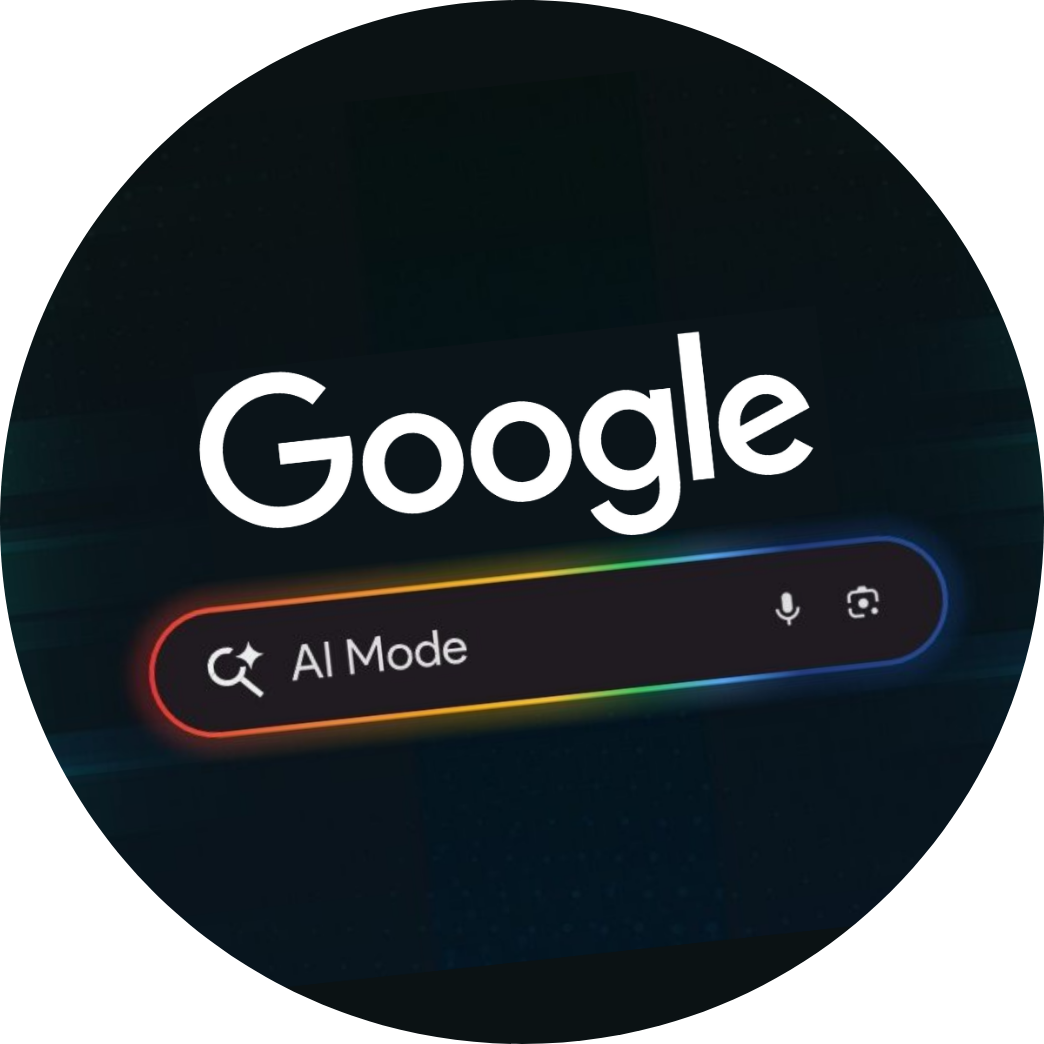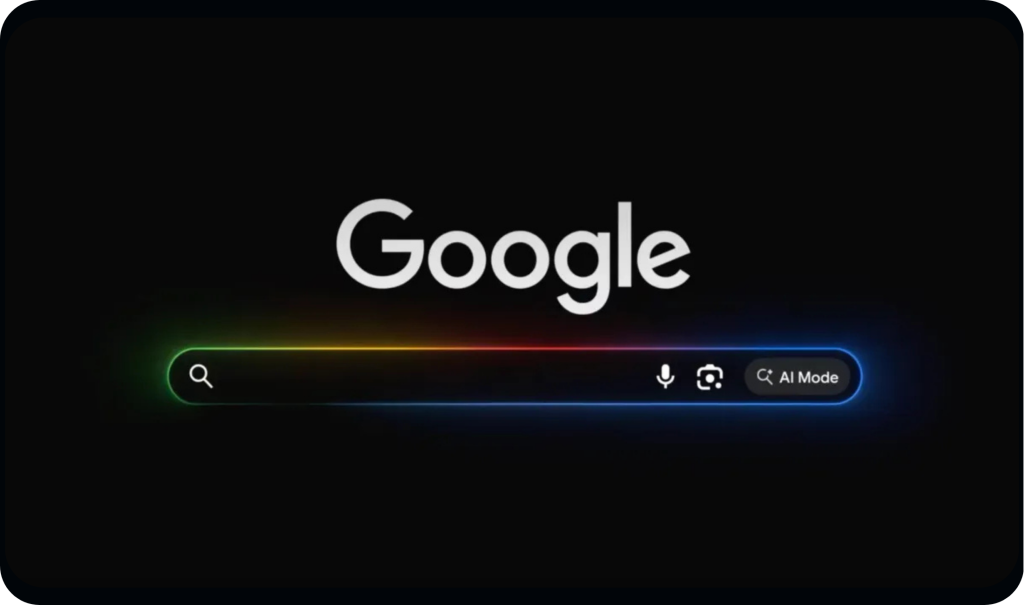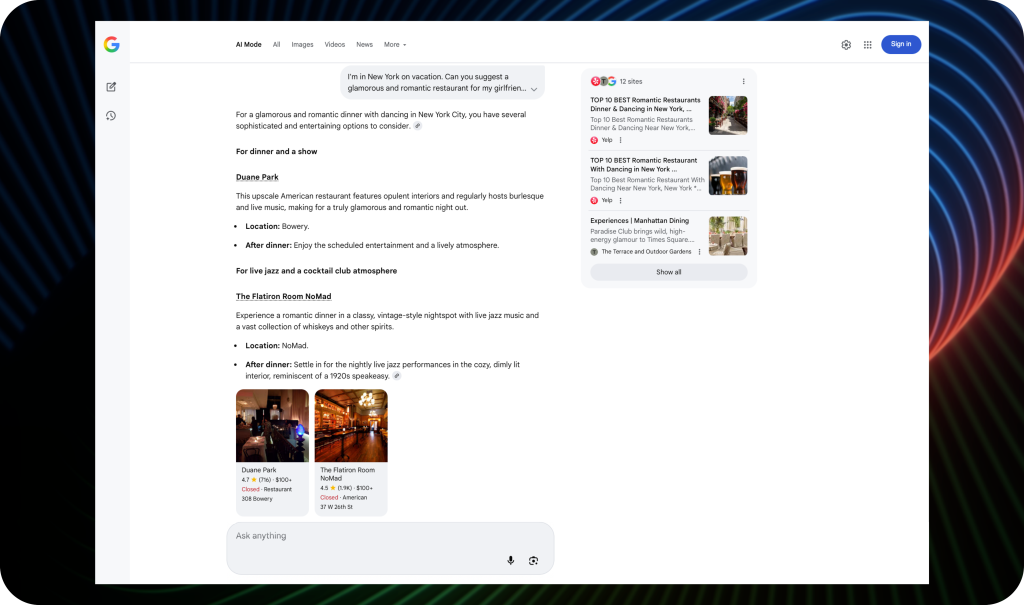
Many have already heard about AI MODE on LinkedIn — a new Google search experience already active in the United States and several other countries around the world, expected to arrive in Europe and Italy by the end of the year.
For those who wish to try it in advance, it’s fully accessible through a VPN connection.
Let’s take a closer look at what it is and how it will change the way we search for information on Google.1

Google AI MODE, officially announced for release in 2025 as an evolution of the previous system known as
“AI Overviews”, no longer provides just an automatic introduction to search results, but a truly conversational
and multi-layered experience. It deeply integrates generative models (such as Gemini) with the traditional
core of the search engine.
Imagine typing a complex query into Google, for example:
“I’m on vacation in New York. Suggest a glamorous and romantic restaurant to take my girlfriend to —
perfect for a couple who also wants to dance and have fun after dinner.”

Instead of returning a list of ten links to explore — in addition to the initial sponsored ones — Google now provides a concise, reasoned, and structured response, enriched with additional links, images, and references, while inviting you to continue with follow-up questions.
This is the essence of what Google calls AI Mode.
Google defines AI Mode as its “most powerful search experience”, capable of reasoning, supporting multimodal input (text, voice, images), handling complex questions, and enabling deeper “explorations” — following a dialogic logic rather than returning a static result.
But beyond the official promises, what changes for those working in digital, content, marketing, and SEO optimization?
And what are the risks, the unknowns, and the emerging strategies?
The query fan-out mechanism
One of the most central and least intuitive aspects of AI Mode is what Google calls query fan-out.
Instead of interpreting the user’s question as a single set of keywords and returning one response or list of documents, the algorithm breaks it down into multiple related micro-queries, which it explores simultaneously.
If you ask “family vacation in France”, the algorithm might generate sub-queries such as “family tours in France”, “cheap flights for families to France”, “kid-friendly attractions in French cities”, “family hotels”, and so on.
Each micro-search draws from different sources and returns fragments of knowledge that are then composed into an organic response.
This approach has significant implications for content creators.
Previously, the goal was to rank for a keyword X. With fan-out, content risks being “quoted” in results without ever being clicked, because the final answer — part conversation, part synthesis — can be self-contained.
In other words, a website can contribute to the AI’s answer without being the destination the user visits.
Even with AI Overviews, many sites already reported major drops in click-through rate (CTR). Several sources cite decreases in visibility of 20–40% compared to traditional search, and anyone managing a site can look at their own analytics to see the impact.
Moreover, Google doesn’t reveal exactly which subqueries are generated: we don’t know which branches of the fan-out lead to visibility or how much weight each has.
This makes traditional keyword-based SEO strategies nearly impossible. It’s as if the algorithm operates in a “black box”, where the semantic constructs that a copywriter considers central are dispersed into countless internal branches, invisible from the outside.
For marketers, this means that thematic relevance and depth — not just keyword density — become essential.
It’s necessary to create content rich in conceptual relationships, with internal coherence, strong internal linking, and a horizontal approach to topics rather than a strictly vertical or niche-focused one.
The risk of dependency on the search engine
When Google AI Mode begins answering user queries directly on the page — with detailed, conversational, and visual responses — there’s a risk that users will have no reason to leave Google.
If the answer is perceived as complete, clicks to external sites become secondary.
This tension already emerged with AI Overviews, where the classic “ten blue links” were progressively pushed below the generative summary.
Now, with AI Mode, Google seems ready to push this even further.
As a response to the rise of tools like ChatGPT, Claude, and others, Google keeps users within its ecosystem — preventing them from leaving for competing AI interfaces.
Furthermore, Google becomes both a neutral search engine and a content creator, since the generative response is a proprietary output of its algorithms.
The associations representing major publishers have reacted strongly:
according to them, AI Mode deprives publishers of traffic and revenue, and represents an arbitrary use of third-party content.
In other words, as Google moves toward a model where it “answers for everyone,” publishers lose one of the main levers of their economic ecosystem.
Toward agentic search
Google isn’t stopping at summarized answers: its stated goal is for AI to act on behalf of the user, executing concrete tasks such as bookings, comparisons, and multi-step actions.
This “agentic” dimension is already being tested and, in some cases, partially available in experimental mode.2
If the system can handle complex tasks — for instance, booking a restaurant, suggesting an itinerary, and adjusting results based on constraints — it becomes an assistant that goes far beyond search.
Google refers to these as agentic capabilities integrated within AI Mode, currently limited to premium users (in the United States) and available experimentally through Search Labs.

Behind the curtain of these features lies an internal project that partly supports them, known as Project Mariner: a prototype of a web agent that, given a specific goal (e.g., find flights to Tokyo, book hotels, rent a car), can browse the web on behalf of the user, interact with websites, fill out forms, and transform an abstract intent into a concrete action.
Mariner is currently available only to a limited group of users, but its integration with Gemini and AI Mode suggests that Google is testing a transition toward a browser + embedded agent model — a sort of answer to ChatGPT’s Instant Checkout, one might say.
If this transition materializes, digital marketers will no longer compete solely for visibility or traffic, but for the ability to be selected by the agent — to become part of the AI’s internal decision-making engine. Becoming “optional” in the agent’s flow, with services, APIs, partnerships, and programmatic interfaces, may soon become more important than traditional textual optimization itself.
SEO in the AI Mode Era: new metrics, new criteria
With AI Mode, the traditional SEO paradigm (keywords, links, titles, meta descriptions) is no longer sufficient. Google’s guidelines state that there are no special requirements to appear in AI Mode and that the approach remains to provide useful, reliable, and well-structured content.3
However, what “useful” means in a context where the algorithm may choose to summarize rather than redirect is very different from before.
First, the concept of E-E-A-T (Experience, Expertise, Authoritativeness, Trustworthiness) takes on a defensive value: the algorithm needs sources it considers reliable, authoritative, and credible to draw paraphrases and fragments from.
Companies with weak, generic, or undifferentiated content risk being ignored altogether.
Competition now revolves around substantive quality — in-depth articles, logical structure, multimedia support, citations of authoritative sources, case studies, and original data.
Next, due to the fan-out mechanism, it’s vital for content to cover the full range of topics surrounding its main theme.
A modular structure — with sections that can serve as standalone answers (independent knowledge blocks) — allows the algorithm to extract relevant portions even when users don’t search for the exact main title.
For example, an article about “garden care” shouldn’t only discuss planting but also include sections on watering, fertilizing, weather protection, tools, and seasonal management.
If the AI fan-out generates a query like “how to water daily”, that specific paragraph can be selected independently for the answer.
In this article, I’m doing exactly that — not just discussing AI Mode, but also what follows from it. 🙂
Equally important is the concept of internal coherence: cross-references, internal links, and the semantic logic that connects related concepts.
If AI Mode can jump between related topics (thanks to fan-out), the text must function as a coherent system, not a collection of disconnected parts.
Keywords and semantic variations should be distributed thoughtfully — not overused — since the AI can recognize and link them even when they aren’t explicitly repeated.
Finally, visibility metrics within AI Mode must be considered.
Google has already introduced dedicated filters in Search Console to view impressions and clicks generated by AI answers.
This may become a crucial indicator: no longer just how many visits a site generates, but how often it is cited or how many impressions AI-generated answers containing its content produce.
Even if clicks decrease, being present within a generated answer can deliver reputational, branding, and awareness benefits.

Impacts on Marketing (Content, Paid, Social)
The revolution brought by AI Mode doesn’t only affect SEO — it transforms the entire digital marketing ecosystem.
Content now becomes primarily a vehicle for knowledge rather than just traffic. Editorial strategies must focus on creating modular assets that can be decomposed and recomposed by AI.
Social campaigns will need to leverage not only click attraction but also visibility within AI-driven dialogues — convincing the algorithm of their relevance.
Regarding advertising, early signals suggest that Google plans to monetize AI Mode: AI-generated response spaces will allow contextual ad placements, with less competition for impressions but higher quality for the remaining clicks.
The effect may be that traditional PPC campaigns lose traction (less visible space, lower diversification), while new forms of advertising embedded in generative responses emerge — linked to specific contexts and micro-intents.
Another frontier is e-commerce: AI Mode is becoming increasingly visual, integrated with the Google Shopping Graph (over 50 billion products), and capable of delivering visual responses and product mosaics.
If a user searches for “light summer dress for women,” the AI may present images, prices, comparisons, and even suggest direct purchase options without visiting the website.
In this scenario, catalog optimization, image quality, accurate product feeds, and rich metadata become essential for visibility within the AI system.
A potential risk arises if Google becomes a true walled garden in search: if users never leave Google, websites lose their central role, and owned channels such as newsletters, sign-ups, and brand experiences gain renewed importance.
Brands that build proprietary assets (communities, apps, exclusive content) will depend less on the algorithm and will be able to engage their audience even outside Google.
Looking ahead, the rise of agentic AI may turn Google into a full intermediary: users will make a request to the AI, which will decide which sources to activate, which tasks to perform, and which sites to contact.
Marketers will need to think about how to become part of that internal decision process — through APIs, integrations, and programmable signals, rather than content alone.
Emerging Scenarios
While Google presents AI Mode as a service to help users, it’s impossible to ignore that this model fundamentally changes the content ecosystem.
A key question arises: how free does the web remain when AI decides what to show, cite, or hide?
Transparency regarding selection criteria, response priorities, and manipulation of content fragments is still limited — and publishers are demanding that Google make these mechanisms public.
The risk of concentration increases: those who already enjoy authority and visibility may be favored as sources cited in AI answers, amplifying their competitive advantage.
Smaller publishers risk being excluded from the synthesis chain, losing visibility even when producing valuable content.
Finally, the pace of change is a challenge in itself: strategies that work today may be obsolete tomorrow.
Adopting an evolutionary mindset — continuous experimentation, adaptation, monitoring, and iteration — becomes essential.
Strategic Actions for Clients and Brands
Faced with this new landscape, what can a digital agency do for its clients, or a brand seeking strong positioning?
There’s no magic formula — just consistent work and a few evolutionary guidelines:
- Embrace the concept of content as a “knowledge kit”: modular, interconnected texts with independent answer blocks.
- Invest in quality, authority, and originality: focus on original data, case studies, real experiences, and unique insights.
- Integrate semantic and relational signals in content with internal consistency, conceptual links, and contextual depth.
- Optimize product catalogs (for e-commerce) with accurate images, well-structured feeds, and rich metadata so AI can recognize products.
- Monitor AI metrics (impressions, citations, AI clicks) using Search Console and other tools — not just traditional visitor data.
- Allocate part of your strategy to proprietary interfaces (apps, newsletters, exclusive content) to build direct relationships with your audience.
- Prepare for agentic AI integration: explore how to offer APIs, meta-services, and interfaces that Google’s agent can invoke.
- Don’t abandon traditional SEO — consider it the foundation: backlinks, solid technical structure, performance, and mobile optimization remain prerequisites for AI visibility.
- Maintain a culture of experimentation and continuous testing, as many AI Mode elements are rapidly evolving and not yet standardized.
References
[1] AI in Search: Going beyond information to intelligence – Google Blog: https://blog.google/products/search/google-search-ai-mode-update/
[2] AI Mode in Search gets new agentic features and expands globally – Google Blog: https://blog.google/products/search/ai-mode-agentic-personalized/
[3] AI Features and Your Website | Google Search Central: https://developers.google.com/search/docs/appearance/ai-features
Continua a leggere
And it consumes less energy.
To return to the page you were visiting, simply click or scroll.


